术语翻译的特征
- 格式:ppt
- 大小:448.00 KB
- 文档页数:42
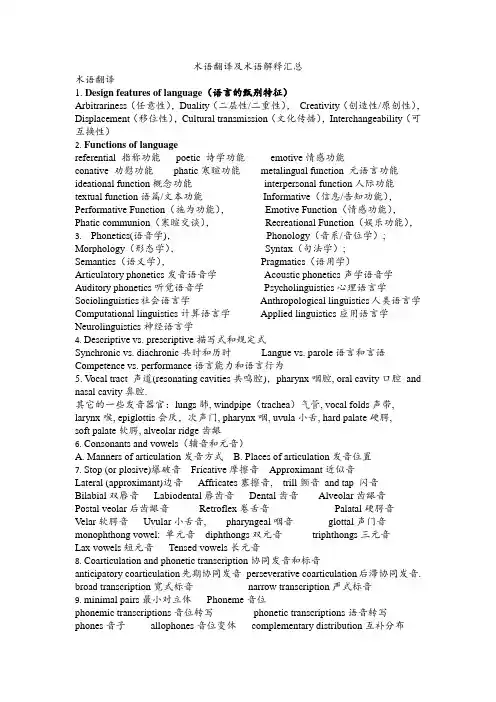
术语翻译及术语解释汇总术语翻译1.Design features of language(语言的甄别特征)Arbitrariness(任意性),Duality(二层性/二重性),Creativity(创造性/原创性),Displacement(移位性),Cultural transmission(文化传播),Interchangeability(可互换性)2. Functions of languagereferential 指称功能poetic 诗学功能emotive情感功能conative 劝慰功能phatic寒暄功能metalingual function 元语言功能ideational function概念功能interpersonal function人际功能textual function语篇/文本功能Informative(信息/告知功能),Performative Function(施为功能),Emotive Function(情感功能),Phatic communion(寒暄交谈),Recreational Function(娱乐功能),3. Phonetics(语音学),Phonology(音系/音位学); Morphology(形态学),Syntax(句法学);Semantics(语义学),Pragmatics(语用学)Articulatory phonetics发音语音学Acoustic phonetics声学语音学Auditory phonetics听觉语音学Psycholinguistics心理语言学Sociolinguistics社会语言学Anthropological linguistics人类语言学Computational linguistics计算语言学Applied linguistics应用语言学Neurolinguistics神经语言学4. Descriptive vs. prescriptive描写式和规定式Synchronic vs. diachronic共时和历时Langue vs. parole语言和言语Competence vs. performance语言能力和语言行为5. V ocal tract 声道(resonating cavities共鸣腔),pharynx咽腔, oral cavity口腔and nasal cavity鼻腔.其它的一些发音器官:lungs肺, windpipe(trachea)气管, vocal folds声带, larynx喉, epiglottis会厌,次声门, pharynx咽, uvula小舌, hard palate硬腭,soft palate软腭, alveolar ridge齿龈6.Consonants and vowels(辅音和元音)A. Manners of articulation发音方式B. Places of articulation发音位置7. Stop (or plosive)爆破音Fricative摩擦音Approximant近似音Lateral (approximant)边音Affricates塞擦音, trill颤音and tap 闪音Bilabial双唇音Labiodental唇齿音Dental齿音Alveolar齿龈音Postal veolar后齿龈音Retroflex卷舌音Palatal硬腭音Velar软腭音Uvular小舌音, pharyngeal咽音glottal声门音monophthong vowel: 单元音diphthongs双元音triphthongs三元音Lax vowels短元音Tensed vowels长元音8.Coarticulation and phonetic transcription协同发音和标音anticipatory coarticulation先期协同发音perseverative coarticulation后滞协同发音. broad transcription宽式标音narrow transcription严式标音9. minimal pairs最小对立体Phoneme音位phonemic transcriptions音位转写phonetic transcriptions语音转写phones音子allophones音位变体complementary distribution互补分布phonetic similarity发音近似性Free variation自由变体assimilation同化regressive assimilation逆同化progressive assimilation顺同化phonological rule 音系规则Epenthesis增音binary 二分的Distinctive features区别特征Endocentric and Exocentric Constructions向心结构和离心结构subordinate and coordinate从属和并列Conceptual meaning概念意义Associative meaning:联想意义Connotative meaning内涵意义Social meaning社会意义Affective meaning情感意义Reflected meaning反射意义Collocative meaning搭配意义Thematic meaning主位意义denotation: 外延意义connotation: 内涵The referential theory:指称理论Semantic triangle语义三角Sense and reference:涵义和指称Synonymy同义关系Antonymy反义关系Hyponymy上下义关系Polysemy一词多义关系Homonymy 同音/形异意关系Dialectal synonyms 地域同义词Stylistic synonyms风格同义词Collocational synonyms搭配同义词gradable antonymy 等级反义关系cover term覆盖项Marked vs. unmarked terms标记项和非标记项complementary antonymy 互补反义关系converse antonymy 逆向反义关系homophones: 同音异义词homographs : 同形异义词complete homonyms semantic components语义部分术语解释1.Design feature的定义:the defining(最典型的,起决定作用的)properties ofhuman language that distinguish it from any animal system of communication. 2.Synchronic共时:It refers to the description of a language at some point of timein history.3.Diachronic历时:It studies the development or history of language. In otherwords, it refers to the description of a language as it changes through time .4.prescriptive规定式:A kind of linguistic s tudy aims to lay down rules for “correctand standard” behavior in using language.5.descriptive描写式: A kind of linguistic study aims to describe and analyze thelanguage people actually use.6.Arbitrariness(任意性):By saying that “language is arbitrary”, we mean thatthere is no logical connection between meaning and sound.7.Duality(二层性/二重性):it means that language is a system, which consists oftwo levels of structures, at the lower level there is the structure of sounds; at the higher level there is the structure of meaning.8.Displacement(移位性): it means that language can be used to communicateabout things that are not present in our immediate communicational context.petence语言能力:it refers to an ideal speaker’s knowledge of the underlyingsystem of rules in a language.10.Performance语言行为: it refers to the actual use of the language by a speaker ina real communicational context.ngue语言: it refers to the speaker’s understanding and knowledge of thelanguage that he speaks.12.Parole言语: it is the actual speaking of language by an individual speaker.13.Cultural transmission(文化传播):It refers to the fact that the details of thelinguistic system must be learned anew(重新,再)by each speaker. Language is not transmitted biologically from generation to generation.14.Phatic communion(寒暄交谈):it refers to ritual exchanges, exchanges that havelittle meaning but help to maintain our relationships with other people.15.Phonetics(语音学): it is the study of the characteristics of speech sounds andprovides methods for their description, classification and transcription.16.V owels元音:the sounds in the production of which no articulators come veryclose together and the air-stream passes through the vocal tract without obstruction.17.Consonants辅音:The sounds in the production of which there is an obstructionof the air-stream at some point of the vocal tract.18.Phonology: it is the study of the sound systems of languages and it is concernedwith the linguistic patterning of sounds in human languages. And it studies the way in which speakers of a language systematically use a selection of these sounds in order to express meaning.19.Phoneme音位: the smallest unit of sound in a language which can distinguish twowords.20.Allophone音位变体: it refers to the different forms of a phoneme.21.Assimilation: it is a process by which one sound takes on some or all thecharacteristics of a neighboring sound.22.Coarticulation: a kind of phonetic process in which simultaneous or overlappingarticulations are involved.plementary distribution互补分布:when two sounds never occur in thesame environment, they are in complementary distribution.24.Free variation自由变体: if two sounds occurring in the same environment do notcontrast, that is, the substitution of one for the other does not produce a different word form, but merely a different pronunciation of the same word, then the two sounds are in free variation.25.Distinctive features区别特征:A phonetic feature which distinguishes onephonological unit, especially one phoneme, from another.26.minimal pairs最小对立体----- which can be defined as pairs of words whichdiffer from each other by only one sound.27.vowel glides滑音: The vowels involving movement from one sound to anotherare called vowel glides.28.Epenthesis增音:it means a process of inserting a sound after another sound.29.Substitution relation: it refers to the relation specifically between an individualunit and others that can replace it in a given sequence.30.Endocentric construction is one whose distribution is functionally equivalent, orapproaching equivalence, to one of its constituents, which serves as the centre, or head, of the whole.31.Exocentric construction: a group of syntactically related words where none ofthem is functionally equivalent to the group as a whole, that is, there is no definable center or head inside the group32.Reference: it is the relationship between words and the objects, actions orproperties that the words stand for. It deals with the extra-linguistic relationships between words and expressions and the world they describe.(具体的物质性的东西)33.Synonymy :It refers to the sameness sense relations between words.ponential analysis :Componential analysis defines the meaning of alexical element in terms of semantic components语义部分.35.Sense: it refers to the complex system of relationships that hold between linguisticelements themselves, it is concerned only with intra-linguistic relations.(概念性的东西)36.Semantics:semantics is the study of the meaning of linguistic units, words andsentences in particular.37.Homonymy: the phenomenon that words having different meanings have the sameform, i.e., different words are identical in sound or spelling, or in both.38.Antonymy:It refers to the oppositeness sense relations between words.39.Hyponymy上下义关系:Hyponymy indicates sense inclusiveness. The upperterm in this sense relation is called superordinate上义词,and the lower terms, hyponyms下义词, members of the same class are called co-hyponyms.。
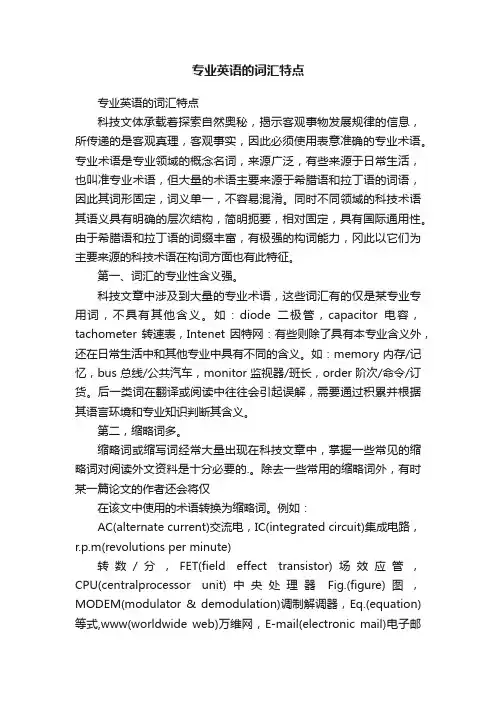
专业英语的词汇特点专业英语的词汇特点科技文体承载着探索自然奥秘,揭示客观事物发展规律的信息,所传递的是客观真理,客观事实,因此必须使用表意准确的专业术语。
专业术语是专业领域的概念名词,来源广泛,有些来源于日常生活,也叫准专业术语,但大量的术语主要来源于希腊语和拉丁语的词语,因此其词形固定,词义单一,不容易混淆。
同时不同领域的科技术语其语义具有明确的层次结构,简明扼要,相对固定,具有国际通用性。
由于希腊语和拉丁语的词缀丰富,有极强的构词能力,冈此以它们为主要来源的科技术语在构词方面也有此特征。
第一、词汇的专业性含义强。
科技文章中涉及到大量的专业术语,这些词汇有的仅是某专业专用词,不具有其他含义。
如:diode二极管,capacitor电容,tachometer转速表,Intenet因特网:有些则除了具有本专业含义外,还在日常生活中和其他专业中具有不同的含义。
如:memory内存/记忆,bus总线/公共汽车,monitor监视器/班长,order阶次/命令/订货。
后一类词在翻译或阅读中往往会引起误解,需要通过积累并根据其语言环境和专业知识判断其含义。
第二,缩略词多。
缩略词或缩写词经常大量出现在科技文章中,掌握一些常见的缩略词对阅读外文资料是十分必要的.。
除去一些常用的缩略词外,有时某一篇论文的作者还会将仅在该文中使用的术语转换为缩略词。
例如:AC(alternate current)交流电,IC(integrated circuit)集成电路,r.p.m(revolutions per minute)转数/分,FET(field effect transistor)场效应管,CPU(centralprocessor unit)中央处理器Fig.(figure)图,MODEM(modulator & demodulation)调制解调器,Eq.(equation)等式,www(worldwide web)万维网,E-mail(electronic mail)电子邮件。

语言学术语翻译的原则和“三从四得”——应姜望琪之“答”侯国金【摘要】从元语言学以及语用翻译学视角考察了语言学术语翻译的问题和方法,在应答姜望琪之“准确观”的过程中,进一步阐释了“系统—可辨性原则”,梳理了术语翻译的准确性以及它同其他诸“性”的对立统一关系,认为“准确性不可丢”,但在难求绝对准确性时可以到准确性的圈外,即“系统性、可辨性(以及可读性、透明性)”那里去“求准”.不存在不服务于系统性和可辨性的可读性和透明性,也不存在有悖于系统性和可辨性的准确性.讨论了透明性的相对性以及它和理据性的相通性,阐释了术语翻译的“三从四得”,即“从他、从众、从已”以及可获得的四种结果.【期刊名称】《外国语文(四川外语学院学报)》【年(卷),期】2011(000)003【总页数】6页(P94-99)【关键词】语言学术语;翻译;准确性;系统性;可辨性;先用性【作者】侯国金【作者单位】四川外语学院外国语文研究中心,重庆400031【正文语种】中文【中图分类】H315.91.引言姜望琪教授所写《论术语翻译的标准》(2005,以下称“姜文1”)发表后,笔者在赞同和感慨之余写了《语言学术语翻译的系统—可辨性原则——兼评姜望琪(2005)》(2009a,下称“拙文”),引来姜老师的新作《再论术语翻译的标准——答侯国金》(2010,下称“姜文2”)。
笔者读后不禁对姜老师生出更深的钦佩来——钦佩他的谦虚、执著和严谨。
姜文1和2都是一个目标,即竖起“术语翻译准确性”的旗帜。
准确译法,译者好求,因此,乍看“准确性”无论如何是不容置疑更不容否定的,因此看到拙文的商榷或质疑,别说姜老师,就连其他任何读者,都可能会怀疑笔者的眼光和学术良知。
若如此,姜文岂非做了一个不证之证,即毋庸置疑的证明?另外,如果其准确指的是“杜绝错误”(姜文,1:p.84)则要求偏低,若是“杜绝错误”基础上的“兼顾准确性、可读性、透明性”的准确(同上),则要求偏高。
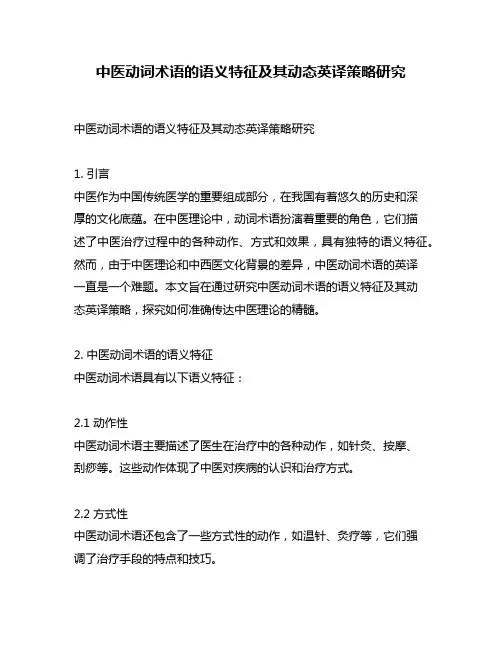
中医动词术语的语义特征及其动态英译策略研究中医动词术语的语义特征及其动态英译策略研究1. 引言中医作为中国传统医学的重要组成部分,在我国有着悠久的历史和深厚的文化底蕴。
在中医理论中,动词术语扮演着重要的角色,它们描述了中医治疗过程中的各种动作、方式和效果,具有独特的语义特征。
然而,由于中医理论和中西医文化背景的差异,中医动词术语的英译一直是一个难题。
本文旨在通过研究中医动词术语的语义特征及其动态英译策略,探究如何准确传达中医理论的精髓。
2. 中医动词术语的语义特征中医动词术语具有以下语义特征:2.1 动作性中医动词术语主要描述了医生在治疗中的各种动作,如针灸、按摩、刮痧等。
这些动作体现了中医对疾病的认识和治疗方式。
2.2 方式性中医动词术语还包含了一些方式性的动作,如温针、灸疗等,它们强调了治疗手段的特点和技巧。
2.3 效果性中医动词术语还描述了治疗的效果,如舒血、顺气、和背等,这些动词突出了治疗的目的和效果。
3. 中医动词术语的动态英译策略为了准确传达中医动词术语的语义特征,我们需要根据实际情况进行动态的英译策略。
3.1 直译法直译法是最常用的翻译策略之一。
对于具有明确含义的中医动词术语,如针灸、按摩等,可以直接使用对应的英文译词。
这样做有利于保持原汁原味,但有时可能会出现译义不准确或不流畅的问题。
3.2 译注法译注法是在翻译中加入注释,解释中医动词术语的含义和用法。
对于中医的刮痧疗法,可以将其翻译为"gua sha (scraping therapy)",并在括号中加入相应的注释。
这样做可以更加准确地传达中医的治疗方式,但可能会让文章显得臃肿。
3.3 归类法归类法是将中医动词术语按照其语义特征进行分类,并选择一个更常用的英文词汇来表示。
将治疗手法中的针灸、火针、毫针等统一翻译为"acupuncture",强调了中医理论中对于针刺疗法的重视。
4. 个人观点与理解在研究和翻译中医动词术语的过程中,我深深感受到中医的博大精深和独特魅力。
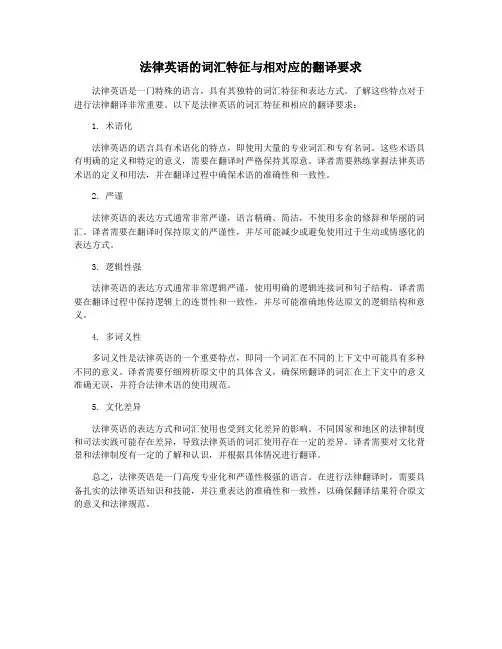
法律英语的词汇特征与相对应的翻译要求
法律英语是一门特殊的语言,具有其独特的词汇特征和表达方式。
了解这些特点对于进行法律翻译非常重要。
以下是法律英语的词汇特征和相应的翻译要求:
1. 术语化
法律英语的语言具有术语化的特点,即使用大量的专业词汇和专有名词。
这些术语具有明确的定义和特定的意义,需要在翻译时严格保持其原意。
译者需要熟练掌握法律英语术语的定义和用法,并在翻译过程中确保术语的准确性和一致性。
2. 严谨
法律英语的表达方式通常非常严谨,语言精确、简洁,不使用多余的修辞和华丽的词汇。
译者需要在翻译时保持原文的严谨性,并尽可能减少或避免使用过于生动或情感化的表达方式。
3. 逻辑性强
法律英语的表达方式通常非常逻辑严谨,使用明确的逻辑连接词和句子结构。
译者需要在翻译过程中保持逻辑上的连贯性和一致性,并尽可能准确地传达原文的逻辑结构和意义。
4. 多词义性
多词义性是法律英语的一个重要特点,即同一个词汇在不同的上下文中可能具有多种不同的意义。
译者需要仔细辨析原文中的具体含义,确保所翻译的词汇在上下文中的意义准确无误,并符合法律术语的使用规范。
5. 文化差异
法律英语的表达方式和词汇使用也受到文化差异的影响。
不同国家和地区的法律制度和司法实践可能存在差异,导致法律英语的词汇使用存在一定的差异。
译者需要对文化背景和法律制度有一定的了解和认识,并根据具体情况进行翻译。
总之,法律英语是一门高度专业化和严谨性极强的语言。
在进行法律翻译时,需要具备扎实的法律英语知识和技能,并注重表达的准确性和一致性,以确保翻译结果符合原文的意义和法律规范。
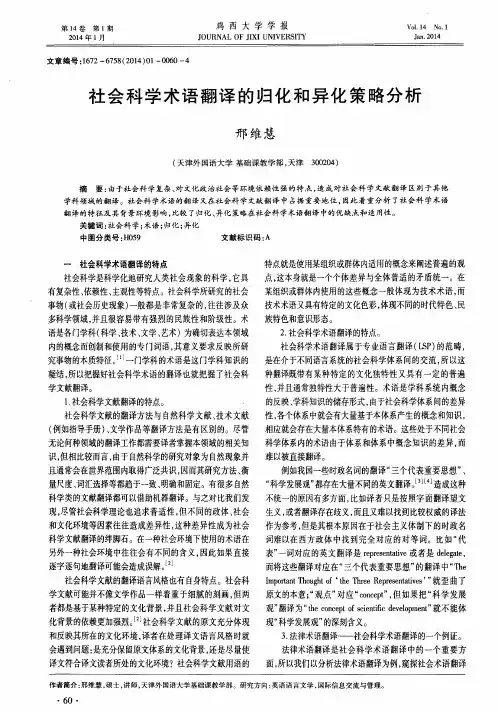
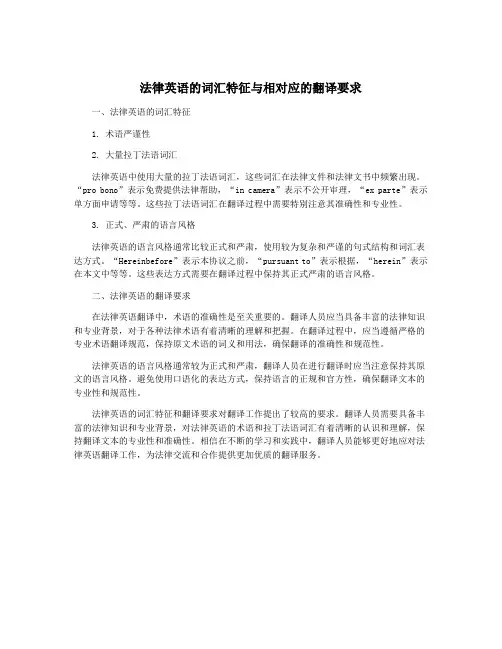
法律英语的词汇特征与相对应的翻译要求
一、法律英语的词汇特征
1. 术语严谨性
2. 大量拉丁法语词汇
法律英语中使用大量的拉丁法语词汇,这些词汇在法律文件和法律文书中频繁出现。
“pro bono”表示免费提供法律帮助,“in camera”表示不公开审理,“ex parte”表示单方面申请等等。
这些拉丁法语词汇在翻译过程中需要特别注意其准确性和专业性。
3. 正式、严肃的语言风格
法律英语的语言风格通常比较正式和严肃,使用较为复杂和严谨的句式结构和词汇表达方式。
“Hereinbefore”表示本协议之前,“pursuant to”表示根据,“herein”表示在本文中等等。
这些表达方式需要在翻译过程中保持其正式严肃的语言风格。
二、法律英语的翻译要求
在法律英语翻译中,术语的准确性是至关重要的。
翻译人员应当具备丰富的法律知识和专业背景,对于各种法律术语有着清晰的理解和把握。
在翻译过程中,应当遵循严格的专业术语翻译规范,保持原文术语的词义和用法,确保翻译的准确性和规范性。
法律英语的语言风格通常较为正式和严肃,翻译人员在进行翻译时应当注意保持其原文的语言风格。
避免使用口语化的表达方式,保持语言的正规和官方性,确保翻译文本的专业性和规范性。
法律英语的词汇特征和翻译要求对翻译工作提出了较高的要求。
翻译人员需要具备丰富的法律知识和专业背景,对法律英语的术语和拉丁法语词汇有着清晰的认识和理解,保持翻译文本的专业性和准确性。
相信在不断的学习和实践中,翻译人员能够更好地应对法律英语翻译工作,为法律交流和合作提供更加优质的翻译服务。
![[翻译研究词典]术语翻译](https://uimg.taocdn.com/e13966c951e2524de518964bcf84b9d528ea2c6a.webp)
[翻译研究词典]术语翻译翻译研究词典1. Absolute Translation 绝对翻译按照古阿德克的解释,指专业译员为应付不同翻译要求⽽采⽤的七种翻译类型之⼀。
在绝对翻译中,整个源⽂本被转换成⽬标语,对原⽂内容和形式都不加以改动。
According to Gouadec, one of seven types of translation which can be used by professional translators to respond to the various translation requirements which can arise during the course of their work. In absolute translation, the whole of ST is transferred into TL, with no alteration to the content or the form of the original document.2. Abstract Translation 摘要翻译古阿德克提出的⽤以应付不同翻译要求的七种翻译策略之⼀。
摘要翻译是将源⽂本的全部信息扼要译出,⽬的是让客户“迅速得到特定类型的信息”。
其⽅法有多种:第⼀种是翻译源⽂本的⼀般主题思想;第⼆种是概述源⽂本的主要内容、⽂本主旨及次要内容;第三种是节录源⽂本中⼀切有⽤的内容。
According to Gouadec, one of seven strategies proposed by Gouadec to fulfill the various translation needs which arise in a professional environment. In abstract translation, a condensed translation of all the information in ST is made in order to give the client "rapid access to specific types of information". This may be done in various ways. Firstly, the generic themes of the text may be translated; secondly, a description may be given of the generic content and the objectives of the text and its sub-units; thirdly, an abridged translation of all the useful content of the text may be supplied.3. Abusive Translation 滥译路易斯⽤来表⽰⽂学翻译中极端做法的⼀个术语。
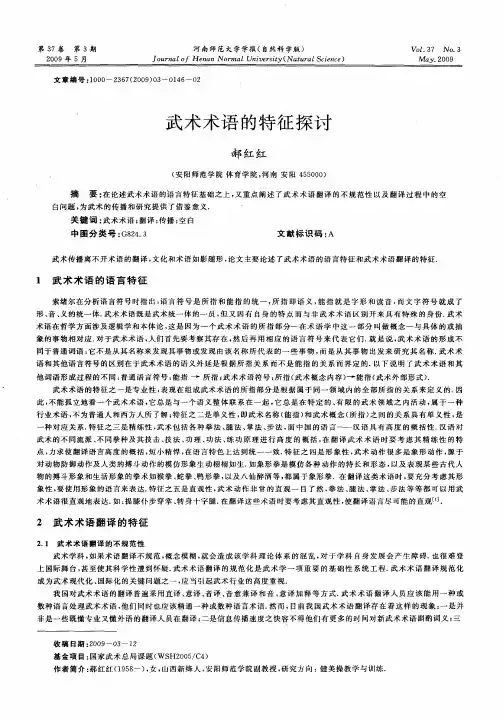
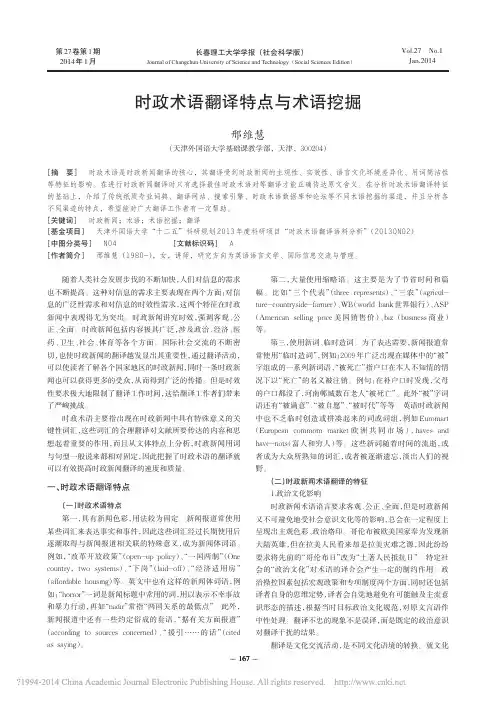
时政术语翻译特点与术语挖掘邢维慧(天津外国语大学基础课教学部,天津,300204)[摘要]时政术语是时政新闻翻译的核心,其翻译受到时政新闻的主观性、实效性、语言文化环境差异化、用词简洁性等特征的影响。
在进行时政新闻翻译时只有选择最佳时政术语对等翻译才能正确传达原文含义。
在分析时政术语翻译特征的基础上,介绍了传统纸质专业词典、翻译网站、搜索引擎、时政术语数据库和论坛等不同术语挖掘的渠道,并且分析各不同渠道的特点,希望能对广大翻译工作者有一定帮助。
[关键词]时政新闻;术语;术语挖掘;翻译[基金项目]天津外国语大学“十二五”科研规划2013年度科研项目“时政术语翻译语料分析”(2013QN02)[中图分类号]N04[文献标识码]A[作者简介]邢维慧(1980-),女,讲师,研究方向为英语语言文学、国际信息交流与管理。
随着人类社会发展步伐的不断加快,人们对信息的需求也不断提高。
这种对信息的需求主要表现在两个方面:对信息的广泛性需求和对信息的时效性需求,这两个特征在时政新闻中表现得尤为突出。
时政新闻讲究时效,强调客观、公正、全面。
时政新闻包括内容极其广泛,涉及政治、经济、医药、卫生、社会、体育等各个方面。
国际社会交流的不断密切,也使时政新闻的翻译越发显出其重要性,通过翻译活动,可以使读者了解各个国家地区的时政新闻,同时一条时政新闻也可以获得更多的受众,从而得到广泛的传播。
但是时效性要求极大地限制了翻译工作时间,这给翻译工作者们带来了严峻挑战。
时政术语主要指出现在时政新闻中具有特殊意义的关键性词汇,这些词汇的合理翻译对文献所要传达的内容和思想起着重要的作用,而且从文体特点上分析,时政新闻用词与句型一般说来都相对固定,因此把握了时政术语的翻译就可以有效提高时政新闻翻译的速度和质量。
一、时政术语翻译特点(一)时政术语特点第一,具有新闻色彩,用法较为固定。
新闻报道常使用某些词汇来表达事实和事件,因此这些词汇经过长期使用后逐渐取得与新闻报道相关联的特殊意义,成为新闻体词语。
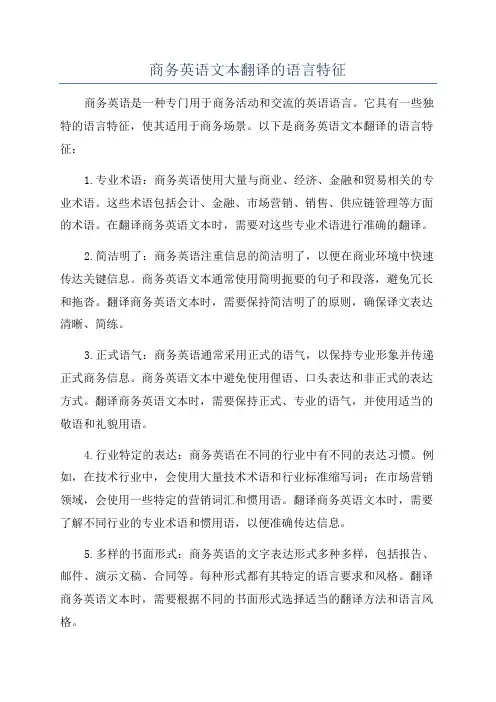
商务英语文本翻译的语言特征商务英语是一种专门用于商务活动和交流的英语语言。
它具有一些独特的语言特征,使其适用于商务场景。
以下是商务英语文本翻译的语言特征:1.专业术语:商务英语使用大量与商业、经济、金融和贸易相关的专业术语。
这些术语包括会计、金融、市场营销、销售、供应链管理等方面的术语。
在翻译商务英语文本时,需要对这些专业术语进行准确的翻译。
2.简洁明了:商务英语注重信息的简洁明了,以便在商业环境中快速传达关键信息。
商务英语文本通常使用简明扼要的句子和段落,避免冗长和拖沓。
翻译商务英语文本时,需要保持简洁明了的原则,确保译文表达清晰、简练。
3.正式语气:商务英语通常采用正式的语气,以保持专业形象并传递正式商务信息。
商务英语文本中避免使用俚语、口头表达和非正式的表达方式。
翻译商务英语文本时,需要保持正式、专业的语气,并使用适当的敬语和礼貌用语。
4.行业特定的表达:商务英语在不同的行业中有不同的表达习惯。
例如,在技术行业中,会使用大量技术术语和行业标准缩写词;在市场营销领域,会使用一些特定的营销词汇和惯用语。
翻译商务英语文本时,需要了解不同行业的专业术语和惯用语,以便准确传达信息。
5.多样的书面形式:商务英语的文字表达形式多种多样,包括报告、邮件、演示文稿、合同等。
每种形式都有其特定的语言要求和风格。
翻译商务英语文本时,需要根据不同的书面形式选择适当的翻译方法和语言风格。
6.文化差异:商务英语的语言使用受到不同文化背景的影响。
不同国家和地区有不同的商务礼仪、商务习惯和商务文化。
在翻译商务英语文本时,需要了解并考虑目标文化的习惯和惯例,确保译文符合当地的商务规范。
7.准确性和一致性:商务英语文本要求准确性和一致性。
任何错误、模糊或不一致的信息都可能导致误导或误解。
因此,在翻译商务英语文本时,需要尽可能准确地传达原文的含义,并保持词汇和术语的一致性。
总之,商务英语文本翻译的语言特征包括专业术语、简洁明了、正式语气、行业特定的表达、多样的书面形式、文化差异以及准确性和一致性。
商务英语术语特征与翻译难点探讨作者:袁森赵慧真来源:《现代商贸工业》2021年第35期摘要:随着中国与国际经济的交往更加深入,中国在国际上的地位日益提高,我国市场对商务英语相关人才和商务英语专业翻译的要求也更加严格。
商务英语术语及其翻译贯穿所有国际商业活动。
大势所趋,顺应时代的发展,译者也应将目光放在商务英语术语方面,结合所学,确保商务英语术语发挥出它真正的作用。
关键词:商务英语;专业术语;翻译中图分类号:F74文献标识码:Adoi:10.19311/ki.1672-3198.2021.35.0220引言商务英语源于人们日常所使用的普通英语,但在商务环境中这些普通英语与商务各领域专业知识相结合,进而产生出新的词义,这样做的目的在于适应职场生活的语言要求。
商务英语属于应用语言的一种,是在英语的基础上强调“商务”,其内容涉及商贸、金融投资、人力资源、物流、市場营销等多个专业领域。
随着全球化进程加快,国际合作加深,我国对外开放进一步扩大,并加强了与西方各国在经济、商务、文化等方面的友好合作。
在这一背景下,专业的商务英语术语翻译逐渐成为社会的主要需求。
1商务英语术语类型1.1外来术语法语或拉丁语源的字汇通常代表着更能凸显专业造诣,所以商务英语中有不少的术语时来自于法语和拉丁语,外来术语使得商务活动更加规范严谨。
如force majeure一词就是从法语发展而来的术语,意为不可抗力。
还有从拉丁语中引申出的proforma一词,意为估算表。
1.2商业术语商业术语就是商务活动中或往来中大量使用的专业术语,一般有固定的表达和相对应的意义,同时商业术语的所包含的领域非常广泛,商务活动中主要依靠商业术语。
例如,commercial channels商业渠道、payment in kind以实物付款等。
1.3新创术语经济社会总是在不断发展的状态中,所以语言也会发生相应的变化,处于新时代的人们逐渐就创造了一些结合时代的新术语。
105摘 要:游乐设施业发展势如破竹,国内外交流日益频繁。
翻译作为沟通的桥梁,其质量不仅关系先进技术发展,也涉及相关人员人身安全及国家资源配置,但该领域的翻译研究却寥若晨星。
术语是科技信息的凝聚,准确的术语表达可让翻译工作事半功倍。
本文结合具体实例,拟对游乐设施业的核心要素——术语——进行特征分析,并从已有译语对应词和尚无译语对应词两方面出发,对术语的翻译方法展开探究。
关键词:游乐设施,术语特征,术语翻译DOI编码:10.3969/j.issn.1674-5698.2021.04.018Features and Translation of Terms in Amusement Ride IndustryMA Ya-ni YU Yan-ying(Xi’an Shiyou University )Abstract: With the rapid development of the amusement ride industry, its exchanges at home and abroad have become increasingly frequent. As a bridge of communication, the quality of translation is related to not only the development of advanced technology, but also the personal safety of relevant personnel as well as the allocation of national resources. However, translation research in this field is rare. Terminology is the condensation of scientific and technological information, and accurate expression of terminology can make translation work get twice the result with half the effort. Combined with specific examples, this paper analyzes the characteristics of terms, which are the core elements of amusement ride industry, and explores the translation methods of terms from two aspects: the existing counterparts in the target language and the lack of counterparts in the target language.Keywords: amusement ride, terminology features, terminology translation作者简介: 马亚妮,硕士研究生,研究方向为术语翻译。
翻译用途特点用途特点是一种在日常生活和商务领域中广泛使用的翻译方法,它的主要特点包括准确性、灵活性、快速性和文化适应性。
以下将详细介绍这些特点。
首先,准确性是用途特点最核心的特征之一。
在翻译过程中,准确传达原文的含义是至关重要的。
用途特点注重将原文的语义、结构和上下文完整地转化为目标语言,并确保目标语言读者能够准确理解原文的意思。
这种准确性不仅体现在语言层面上的精确,还包括对原文中的文化因素、隐含信息和特定术语的准确理解和传达。
其次,灵活性是用途特点的另一个特点。
灵活性指的是翻译者可以根据具体的翻译任务和需求采用不同的翻译策略和技巧。
这种灵活性使得翻译者能够根据原文的特点和目标语言读者的需求,选择合适的转译方式,如字面翻译、意译、加注释或修改原文结构等。
灵活性还包括对不同领域和专业术语的掌握和运用,以便更好地传达原文的含义。
第三,快速性是用途特点的又一个重要特点。
尤其在商务和跨国交流中,翻译通常需要在有限的时间内完成。
用途特点通过高效的翻译技巧和流程,以及熟悉相关领域和文化的翻译者,使得翻译能够在较短的时间内完成。
这种快速性是实现及时沟通和交流的关键,使得原文作者和目标语言读者能够在快速变化的环境中有效地传递信息。
最后,文化适应性是用途特点的另一个重要特点。
翻译除了要准确传达原文的意思,还需要考虑目标语言读者的文化特点和背景。
用途特点注重翻译的文化适应性,即考虑目标语言读者的习惯、价值观和文化背景,在翻译过程中根据具体情境进行必要的文化调整。
这种文化适应性不仅有助于增强翻译的可理解性,还能避免信息误解或文化冲突,提高翻译的交际效果和接受度。
总结来说,用途特点在翻译中具有准确性、灵活性、快速性和文化适应性等特点。
这些特点使得用途特点成为一种通用而有效的翻译方法,能够满足不同领域和场景中的翻译需求,促进不同语言和文化之间的有效沟通和交流。
同时,用途特点也需要翻译者拥有深厚的语言和文化素养,以及良好的翻译技巧和策略,才能更好地实现翻译的目标和效果。
摘要:法律英语专业术语是最正式、最规范的法律语言。
具有专业性、严谨性、相对模糊性及对义性等特征。
在翻译法律英语专业术语时,应该灵活地采用直译、意译、使用内涵最接近的功能对等词、进行必要的解释、以及适度的增减词等方法,准确地传递原文中术语的意义。
了解及掌握法律英语专业术语的特点及翻译技巧,对于我们从事法律文件的翻译具有一定的指导意义。
关键词:法律英语;专业术语;翻译法律英语是以英语为工具用以表述法律科学概念及诉讼或非诉讼法律事务时所使用的语言,是在立法和司法等活动中形成和使用的具有法律专业特点的语言。
法律英语主要由法律术语、法律工作常用词语和民族共同语中的其他基本词和非基本词构成,而法律术语是其中的重要词汇成员。
专业术语的作用在于以最简洁的单词或词组叙述一项普遍接受的复杂的法律概念、学说或法则,使法律人能用较简洁的语言相互沟通,但是,因为每种法律评议的一套专用术语相对应的是一套法律概念系统,而且与其他词语相比,法律专用术语更能体现某一法律体系或体制的典型特征。
因此,在法律翻译中,研究专业术语的特点及其翻译方法非常重要。
一、法律英语专业术语的特征一般地说,法律英语专业术语主要分为三类:由一般术语演变的专业术语;纯专业术语;借用其它学科的专业术语。
法律英语专业术语具有以下特征:首先,专业术语的词义具有明显的专业性。
专业术语使用频繁,而且最具有法律语言的特征。
法律专业术语专业性体现在它们仅仅出现在法律语体中,并使法律语体区别于其他语体。
比如我国“对外贸易法”这部法律中有十处提到“应当”这个词,具有英语常识的人都知道,在普通英语中,“应当”的常用词汇有be supposed to,should,be ought to等。
但这些词汇无法表达法律上的“义务”、“责任”,属普通用词;英文法律中表示“应当”的常用词语为shall。
其次,专业术语的严谨性。
法律术语最突出的特点是词义单一而固定,每个专业术语所表示的都是一个特定的法律概念,在使用时其他任何词语都不能代替。